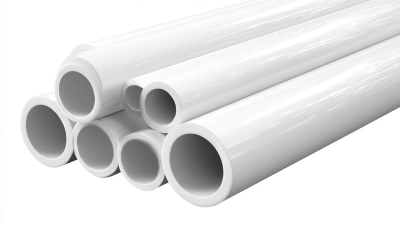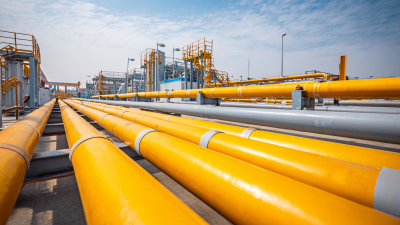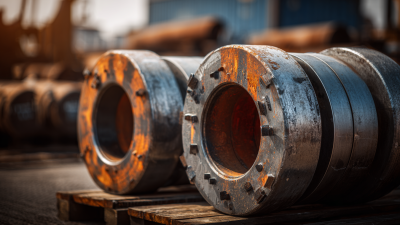Email Id: sale@adctooling.com
 In the evolving landscape of industrial piping systems, the quest for efficiency and durability has led to the increased adoption of specialized materials such as PTFE lined pipe. According to a report by MarketsandMarkets, the global market for PTFE is expected to reach USD 2.7 billion by 2025, driven by its unique properties that enhance performance in various applications, particularly in chemical processing. PTFE lined pipes are renowned for their exceptional resistance to corrosion, high temperatures, and non-stick properties, making them an ideal choice for transporting aggressive fluids. As industries face growing pressure to enhance productivity while minimizing maintenance costs, the advantages of PTFE lined pipe emerge as a compelling alternative to traditional materials. By maximizing efficiency through superior fluid handling capabilities, businesses can not only safeguard their infrastructure but also optimize overall operational performance.
In the evolving landscape of industrial piping systems, the quest for efficiency and durability has led to the increased adoption of specialized materials such as PTFE lined pipe. According to a report by MarketsandMarkets, the global market for PTFE is expected to reach USD 2.7 billion by 2025, driven by its unique properties that enhance performance in various applications, particularly in chemical processing. PTFE lined pipes are renowned for their exceptional resistance to corrosion, high temperatures, and non-stick properties, making them an ideal choice for transporting aggressive fluids. As industries face growing pressure to enhance productivity while minimizing maintenance costs, the advantages of PTFE lined pipe emerge as a compelling alternative to traditional materials. By maximizing efficiency through superior fluid handling capabilities, businesses can not only safeguard their infrastructure but also optimize overall operational performance.
PTFE lined pipes, crafted from a combination of durable piping materials and a protective layer of polytetrafluoroethylene (PTFE), offer a unique solution for various industrial applications. The PTFE lining acts as a barrier, preventing corrosion and erosion caused by aggressive chemicals and high temperatures. This composition not only extends the lifespan of the pipes but also ensures that the fluid being transported maintains its integrity and quality.
One of the most significant benefits of PTFE lined pipes is their exceptional non-stick properties. This characteristic minimizes the buildup of materials inside the piping system, leading to reduced maintenance requirements and enhanced flow efficiency. Additionally, PTFE's high chemical resistance allows these pipes to handle a wide range of substances without compromising performance, making them ideal for industries such as pharmaceuticals, food processing, and chemical manufacturing. By choosing PTFE lined pipes, businesses can optimize their operations while ensuring safety and compliance with industry standards.

PTFE linings have emerged as a game-changer in various piping applications, offering significant advantages that enhance efficiency and durability. One key advantage of using PTFE is its exceptional chemical resistance, making it suitable for handling aggressive fluids found in industries like food processing and chemical manufacturing. For instance, food and beverage plants are increasingly adopting PTFE-lined hoses to ensure compliance with hygiene standards while maximizing production line efficiency. The durability of PTFE also minimizes maintenance needs, leading to reduced downtime and increased output.
Moreover, recent advancements in PTFE technology, such as convoluted designs, have expanded its applications in high-performance realms, including automotive industries. These improvements cater specifically to specialized needs, such as dry sump oiling systems in racing cars. The ability to adapt to new race fuel chemistries showcases how PTFE linings are not only versatile but also crucial in meeting the demands of modern engineering challenges. As industries continue to evolve, PTFE-lined piping systems will remain at the forefront, delivering the reliability and performance necessary for success.
When comparing PTFE lined pipes to traditional materials such as stainless steel and carbon steel, several key advantages emerge that significantly boost operational efficiency. According to a study by the Chemical Engineering Research Journal, PTFE's exceptional chemical resistance allows it to withstand aggressive chemicals and extreme temperatures, making it a preferred choice in industries such as pharmaceuticals and petrochemicals. Traditional materials often require frequent maintenance and replacement when exposed to harsh environments, leading to increased downtime and operational costs.
Furthermore, PTFE lined pipes have lower frictional resistance than their traditional counterparts, resulting in improved flow rates and reduced energy consumption. A report from the American Society of Mechanical Engineers indicates that the use of PTFE can enhance fluid transfer efficiency by up to 30%. This translates to less energy required to pump fluids, which is a critical factor in reducing operational costs in large-scale manufacturing processes. Additionally, the lightweight nature of PTFE compared to traditional metals simplifies installation processes and reduces transportation costs, further exemplifying the benefits of this innovative piping solution.
| Property/Aspect | PTFE Lined Pipes | Traditional Materials |
|---|---|---|
| Corrosion Resistance | Excellent | Moderate |
| Temperature Range | -196°C to 260°C | -40°C to 120°C |
| Weight | Lightweight | Heavy |
| Maintenance | Low | High |
| Friction Coefficient | Very Low | Higher |
| Cost | Higher Initial Investment | Lower Initial Investment |
| Lifespan | Longer | Shorter |
PTFE lined pipes are revolutionizing various industries with their unique properties that enhance efficiency and safety. In the chemical processing sector, these pipes are essential for transporting corrosive substances without the risk of leakage or damage. The smooth surface of PTFE reduces friction and turbulence, allowing for a more efficient flow of chemicals, ultimately lowering operational costs and increasing productivity. This is especially crucial in applications where precise handling of hazardous materials is required.
Beyond chemical processing, PTFE lined pipes are widely used in the food and pharmaceutical industries. In food processing, the non-stick surface ensures that products do not adhere to the pipes, maintaining the purity and quality of the materials being transported. Similarly, in pharmaceuticals, these pipes prevent contamination and ensure compliance with stringent hygiene regulations. The versatility of PTFE lined pipes makes them an ideal choice across various applications, ensuring optimal performance while minimizing risks associated with corrosion and contamination.

When it comes to the installation and maintenance of PTFE lined pipes, adhering to best practices can significantly enhance their lifespan and efficiency. According to a recent industry report by the American Society of Mechanical Engineers (ASME), proper installation techniques can reduce the risk of leaks by up to 40%. This is crucial, as PTFE lined pipes are engineered to handle highly corrosive substances, and any compromise in integrity can lead to catastrophic failures.
To ensure optimal performance, regular maintenance is key. The Chemical Engineering Journal cites that facilities employing a predictive maintenance schedule see a 25% decrease in downtime related to pipe failures. Operators should regularly inspect the condition of the PTFE lining, checking for signs of wear or degradation. Use of ultrasound testing can provide vital information about the thickness of the lining, allowing for timely interventions before issues arise. Furthermore, maintaining proper operating temperatures and pressures recommended by manufacturers can prevent stress-related fatigue and extend the life of the piping system.
Additionally, training personnel on the unique characteristics of PTFE lined pipes can lead to improved handling and installation practices. The Plastics Pipe Institute notes that over 75% of installation-related failures are attributed to human error. Regular workshops and training sessions can bridge this knowledge gap, ensuring that all staff are aware of the specific properties and requirements for PTFE lined systems, leading to a safer and more effective operational environment.




